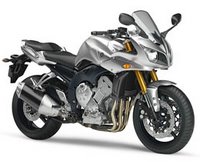Company: Yamaha
Agency : Dentsu
Yamaha which once ruled the mind of Indian youth is now in dire straits. The company which is the second largest motorcycle manufacturer in the world is having a market share of 5%
 in the booming Indian two wheeler market which is growing at a rate of 12-15%.
in the booming Indian two wheeler market which is growing at a rate of 12-15%.Why?
Yamaha is a performance bike manufacturer which recently celebrated its golden jubilee of its existence . In India Yamaha was present in a joint venture with Escorts which brought out the blockbuster Yamaha RX 100 and the cult Yamaha RD 350. Yamaha and Hero Honda had during the late 80's beat the hell out of scooter manufacturers , but Yamaha now has lost its edge. Yamaha broke the partnership with Escorts and started its India operations as a 100% subsidiary of Yamaha Japan from 2001 onwards.
Yamaha was not able to sustain the momentum it had generated during 1990's with RX100. RX100 was a bike that had style and substance. The product was powerful, gave no mech problems and was embraced by the youth. But after the tight environmental regulations introduced in 90's , RX100 had to be shelved. RX100 was replaced by RX135 which was no where near RX100. The ride was terrible and the product had nothing to boast about. It was the beginning of decline of Yamaha.
Yamaha was not able to bringout a blockbuster product in the recent past. It is unfair if I don't mention that there were lot product launches from Yamaha but nothing clicked. The reason being that the company was focused on Utility segment ( true that money is there only in that segme
 nt). Yamaha did not try to look at the changing profile of the Indian consumer.
nt). Yamaha did not try to look at the changing profile of the Indian consumer.Yamaha also thought that it had the same premium image in the mind of the customer . It failed to realise that the brand equity has eroded because of failed product launches. It had no product to showcase its superiority as a bike manufacturer. While Bajaj demonstrated its arrival in to the bike segment with Eliminator and Pulsar, Yamaha still tried its luck in the executive segment which was dominated by Splendor from Hero Honda.
Yamaha should have realised that inorder to break the Splendor's dominance, It had to build a brand in the premium segment and using that image, try its luck in the mid segment. Bajaj launched Eliminator to show the technical superiority. We drooled at the cruiser and then grabbed Pulsar. Yamaha failed to do that.
Yamaha
 tried to shock the market with a low priced Cruiser Enticer at an unbelievable price of 49000 but the product failed because the company wanted to play the volume game. Enticer could not sustain the huge initial it got because the market for cruiser was only emerging and the product did not live up to the expectation. Cruiser with only a power of 125 cc was itself a failing proposition. Now that there is a trend towards low priced cruiser pioneered by Bajaj Avenger, Enticer relaunch may succeed.
tried to shock the market with a low priced Cruiser Enticer at an unbelievable price of 49000 but the product failed because the company wanted to play the volume game. Enticer could not sustain the huge initial it got because the market for cruiser was only emerging and the product did not live up to the expectation. Cruiser with only a power of 125 cc was itself a failing proposition. Now that there is a trend towards low priced cruiser pioneered by Bajaj Avenger, Enticer relaunch may succeed.Yamaha then launched Crux and Libero and Fazer in the executive segment but cou
 ld not set the market on fire . The company says that it is moving away from utility bikes to performance bikes. The launch of Fazer was towards this direction. The product had an unusual look hence failed to catch the imagination of Indian bike enthusiasts. Here again the company made a mistake of not making a statement.
ld not set the market on fire . The company says that it is moving away from utility bikes to performance bikes. The launch of Fazer was towards this direction. The product had an unusual look hence failed to catch the imagination of Indian bike enthusiasts. Here again the company made a mistake of not making a statement.Yamaha is having big plans for India. The company is earmarking 200 crores in revamping its operations. On the marketing side, it has roped in John Abraham as the brand ambassador.
I am no expert in Motorcycles but I feel that Yamaha now needs to make a STATEMENT. A powerful statement that will force the consumers to look up and say " Its a Yamaha".
 compare the Fazer launched in India and the Fazer which is showcased int
compare the Fazer launched in India and the Fazer which is showcased int ernationally, the Indian Fazer is no where near the international one. Why did Yamaha which wanted to play the lifestyle game launch a stripped down Fazer ? Had it launched a chunky masculine Yamaha in India, the brand will move miles ahead in the mind of the consumer. Forget the price and the volume, bring the best bike to India and make a statement.
ernationally, the Indian Fazer is no where near the international one. Why did Yamaha which wanted to play the lifestyle game launch a stripped down Fazer ? Had it launched a chunky masculine Yamaha in India, the brand will move miles ahead in the mind of the consumer. Forget the price and the volume, bring the best bike to India and make a statement. 






